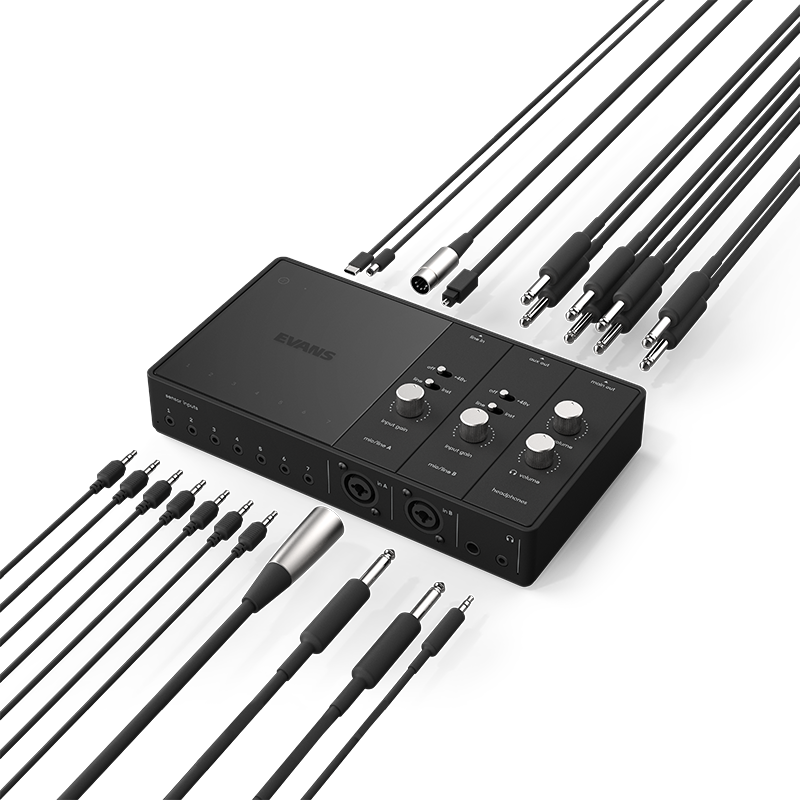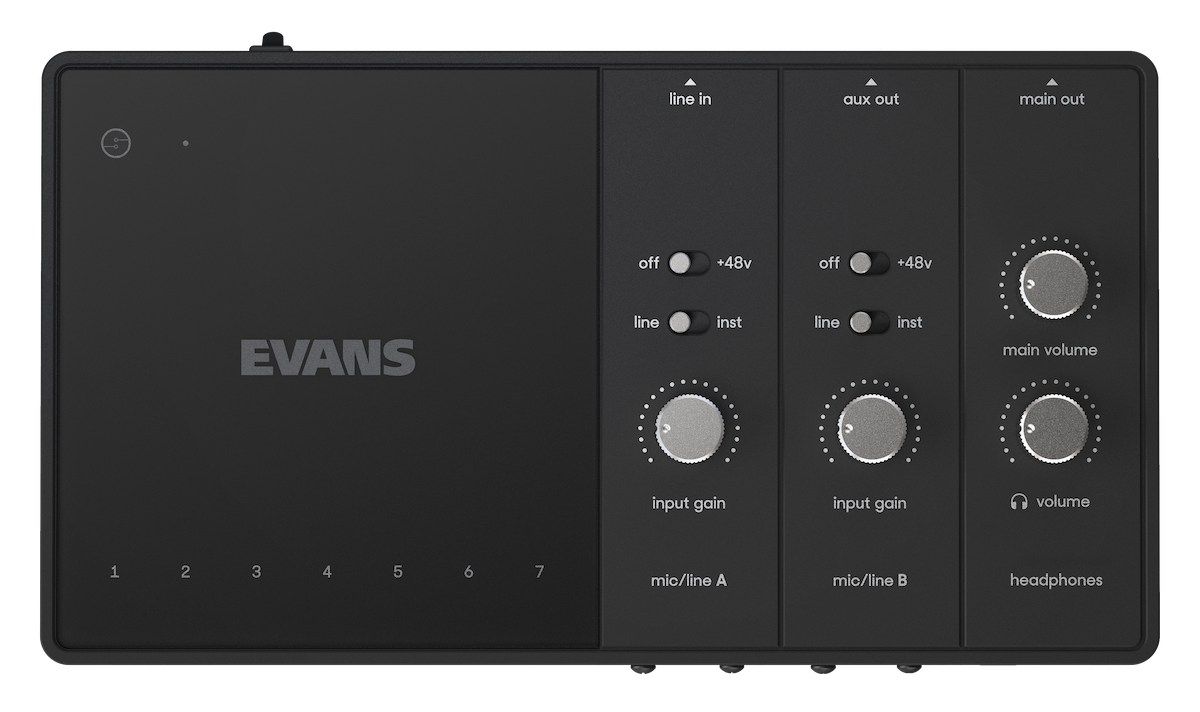EVANS Sensory Percussion Portal

The EVANS Sensory Percussion Portal allows you to connect up to 7 Drum Sensors and a range of other devices to the Sensory Percussion software. It also includes many output options for monitoring your sound or sending it to a PA or mixing board.
Front Panel

Sensor Inputs (1-7)
The EVANS Sensory Percussion Portal include 7 Sensor inputs - these inputs are "plug-and-play" with no gain adjustment or phantom power setting required. Use the included 3.5 mm TRS cables to connect your Sensors to the EVANS Sensory Percussion Portal. When the cable is plugged into the Sensor Inputs, you will see the indicator light on the top of the EVANS Sensory Percussion Portal light up for that channel.
Combo XLR/Instrument inputs (A/B)
These two inputs are "Combo" input sockets and can be used to connect microphones, instruments (like guitars) or line-level signals. The input accepts standard XLR plugs and 1/4" jacks (TS or TRS). See Combo XLR/Line Input Controls for more information on configuring these inputs.
Built-in Microphone
The EVANS Sensory Percussion Portal comes with a built-in MONO Microphone. This Microphone is used by the software for advanced automatic cross-talk cancellation and can also be accessed as a microphone source in the software.
Headphone Outputs
Connect one or two pairs of stereo headphones to the 3.5 mm and 1/4" headphone inputs. The two jacks share the same output channels and are controlled together by the Headphone Volume knob on the top of the EVANS Sensory Percussion Portal.
Back Panel

Main Outputs (L/R)
The EVANS Sensory Percussion Portal includes two balanced analogue line outputs on 1/4" jack sockets. The output jacks accept either TRS (for balanced) or TS (for unbalanced) plug types. These are the outputs to drive the primary monitoring system (a house PA for example). The Main Outs can be controlled with the Main Outs Volume Knob on the top of the EVANS Sensory Percussion Portal.
Auxiliary Outputs (5-8)
These Line Outputs work just like the Main Outputs except they do not have a dedicated hardware volume knob. Use these for extra speakers, submixes, or whatever you like!
Line-level Inputs (C/D)
The EVANS Sensory Percussion Portal includes an additional 2 balanced line-level inputs. Use TRS cables for balanced or TS cables for unbalanced
ADAT Output (1-8)
The EVANS Sensory Percussion Portal includes a TOSLINK connector to send an additional 8 channels of digital audio in ADAT format to any device with a compatible ADAT Input. These additional output channels are configurable within the Sensory Percussion software.
MIDI-Out (5-pin)
Use the 5-Pin MIDI DIN sockets to send MIDI through the EVANS Sensory Percussion Portal to older devices that don't support USB.
Power
Use the included 12-volt DC, 2-amp AC adaptor (PSU) to power the EVANS Sensory Percussion Portal interface. Note: The Portal cannot accept power via its USB-C port).
USB-C Port
USB 2.0 port - Type C Connector. Please use the supplied cable to connect your EVANS Sensory Percussion Portal to your computer. If your computer does not have a USB-C port, we strongly recommend using only USB-Certified Type A-to Type C cables or adapters. Using an uncertified cable can cause permanent damage to your EVANS Sensory Percussion Portal device and void your warranty.
Kensington Lock security slot
Use this slot to secure your EVANS Sensory Percussion Portal to whatever you like.
Top Panel

Combo XLR/Line Input Controls
Each Combo Input Channel on the front panel comes with a line/instrument, 48v phantom power switch, and a gain knob. You will want to adjust these switches depending on your input source.
+48v Phantom Power
When this switch is set to +48v the EVANS Sensory Percussion Portal will provide the standard 48v phantom power to any XLR input. Note that this setting does not apply when 1/4" jacks are plugged in. Note: Do not connect anything other than a microphone to the XLR input -- especially if phantom power is enabled -- or you might seriously damage your gear and void your warranty.
line/instrument
Set this switch to inst when you would like to use hi-impedance instruments, like guitars. Set it to line for line-level sources. This switch only applies to devices using a 1/4" plug type.
Gain
Use the Gain Knob to set the input gain on your microphone or device. Use the input meters within the Sensory Percussion software to monitor your gain level and to check if your input is peaking.
Example use cases
| Input device | Input type | +48v | line/inst |
|---|---|---|---|
| Condenser microphone | XLR | +48v | -- |
| Dynamic microphone | XLR or 1/4" | -- | -- |
| Guitar | 1/4" | -- | inst |
| Synth | 1/4" | -- | line |
Note: Please always follow the manufacturer's instructions for your particular microphone or device
Headphone Volume Knob
This knob controls the volume of the two headphone jacks on the front panel. The two headphone ports are always at the same volume.
Main Output Volume Knob
This knob controls the volume of the two Main Outs (L/R) on the back panel.
EVANS Sensory Percussion Portal Channel List
| Input Channel | PORTAL Name |
|---|---|
| 1 | Mic/Line A |
| 2 | Mic/Line B |
| 3 | Line-In C |
| 4 | Line-In D |
| 5 | Sensor 1 |
| 6 | Sensor 2 |
| 7 | Sensor 3 |
| 8 | Sensor 4 |
| 9 | Sensor 5 |
| 10 | Sensor 6 |
| 11 | Sensor 7 |
| 12 | Built-in Mic |
| Output Channel | PORTAL Name |
|---|---|
| 1 | Main Out L |
| 2 | Main Out R |
| 3 | Headphone L |
| 4 | Headphone R |
| 5 | Aux Out 5 |
| 6 | Aux Out 6 |
| 7 | Aux Out 7 |
| 8 | Aux Out 8 |
| 9 | ADAT Out 1 |
| 10 | ADAT Out 2 |
| 11 | ADAT Out 3 |
| 12 | ADAT Out 4 |
| 13 | ADAT Out 5 |
| 14 | ADAT Out 6 |
| 15 | ADAT Out 7 |
| 16 | ADAT Out 8 |